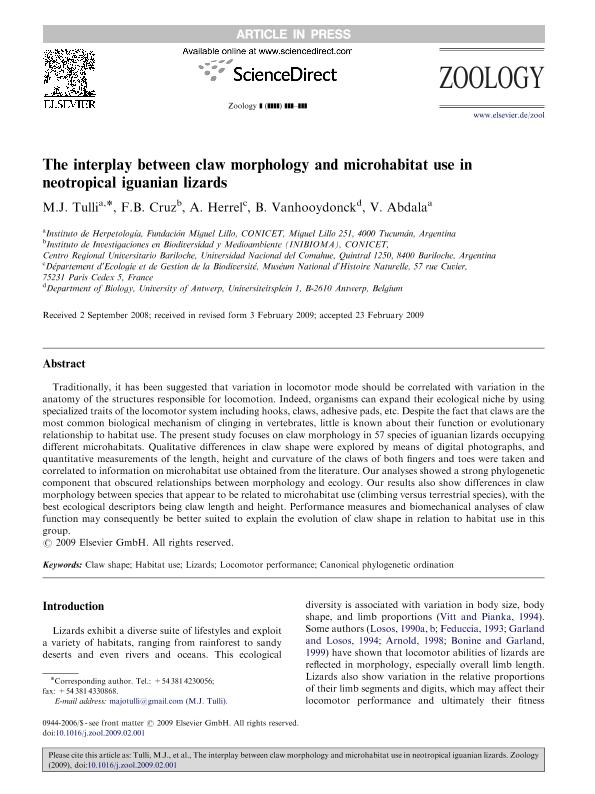Mostrar el registro sencillo del ítem
dc.contributor.author
Tulli, María José

dc.contributor.author
Cruz, Felix Benjamin

dc.contributor.author
Herrel, Anthony

dc.contributor.author
Vanhooydonck, Bieke
dc.contributor.author
Abdala, Virginia Sara Luz

dc.date.available
2019-06-12T14:30:44Z
dc.date.issued
2009-09
dc.identifier.citation
Tulli, María José; Cruz, Felix Benjamin; Herrel, Anthony; Vanhooydonck, Bieke; Abdala, Virginia Sara Luz; The interplay between claw morphology and microhabitat use in neotropical iguanian lizards; Elsevier Gmbh; Zoology; 112; 5; 9-2009; 379-392
dc.identifier.issn
0944-2006
dc.identifier.uri
http://hdl.handle.net/11336/78058
dc.description.abstract
Traditionally, it has been suggested that variation in locomotor mode should be correlated with variation in the anatomy of the structures responsible for locomotion. Indeed, organisms can expand their ecological niche by using specialized traits of the locomotor system including claws, adhesive pads, etc. Despite the fact that claws are the most common biological mechanism of clinging in vertebrates, little is known about their function or evolutionary relationship to habitat use. The present study focuses on claw morphology across lizards occupying different microhabitats in 57 species of iguanian lizards. Qualitative differences in claw shape were explored by means of digital photographs and quantitative measurements of the length, height and curvature of the claws of both fingers and toes were taken and correlated to information on microhabitat use obtained from the literature. Our analyses showed a strong phylogenetic component, obscuring relationships between morphology and ecology with animals occupying similar habitats often being closely related. Our results also show differences in claw morphology between species that appear to be related to microhabitat use (climbing versus terrestrial species), with the best ecological descriptors being claw length and height. Performance measures and biomechanical analyses of claw function may consequently be better suited to explain the evolution of claw shape in relation to habitat use in this group.
dc.format
application/pdf
dc.language.iso
eng
dc.publisher
Elsevier Gmbh

dc.rights
info:eu-repo/semantics/openAccess
dc.rights.uri
https://creativecommons.org/licenses/by-nc-sa/2.5/ar/
dc.subject
Claw Shape
dc.subject
Habitat Use
dc.subject
Lizards
dc.subject
Locomotor Performance
dc.subject
Canonical Phylogenetic Ordination
dc.subject.classification
Otras Ciencias Biológicas

dc.subject.classification
Ciencias Biológicas

dc.subject.classification
CIENCIAS NATURALES Y EXACTAS

dc.title
The interplay between claw morphology and microhabitat use in neotropical iguanian lizards
dc.type
info:eu-repo/semantics/article
dc.type
info:ar-repo/semantics/artículo
dc.type
info:eu-repo/semantics/publishedVersion
dc.date.updated
2019-06-10T13:54:37Z
dc.journal.volume
112
dc.journal.number
5
dc.journal.pagination
379-392
dc.journal.pais
Alemania

dc.journal.ciudad
Heidelberg
dc.description.fil
Fil: Tulli, María José. Fundación Miguel Lillo. Dirección de Zoología. Instituto de Herpetología; Argentina. Consejo Nacional de Investigaciones Científicas y Técnicas. Centro Científico Tecnológico - Tucumán. Unidad Ejecutora Lillo; Argentina
dc.description.fil
Fil: Cruz, Felix Benjamin. Consejo Nacional de Investigaciones Científicas y Técnicas. Centro Científico Tecnológico Conicet - Patagonia Norte. Instituto de Investigaciones en Biodiversidad y Medioambiente. Universidad Nacional del Comahue. Centro Regional Universidad Bariloche. Instituto de Investigaciones en Biodiversidad y Medioambiente; Argentina
dc.description.fil
Fil: Herrel, Anthony. Muséum National d’Histoire Naturelle; Francia
dc.description.fil
Fil: Vanhooydonck, Bieke. University of Antwerp; Países Bajos
dc.description.fil
Fil: Abdala, Virginia Sara Luz. Fundación Miguel Lillo. Dirección de Zoología. Instituto de Herpetología; Argentina. Consejo Nacional de Investigaciones Científicas y Técnicas. Centro Científico Tecnológico Conicet - Tucumán. Instituto de Biodiversidad Neotropical. Universidad Nacional de Tucumán. Facultad de Ciencias Naturales e Instituto Miguel Lillo. Instituto de Biodiversidad Neotropical. Instituto de Biodiversidad Neotropical; Argentina
dc.journal.title
Zoology

dc.relation.alternativeid
info:eu-repo/semantics/altIdentifier/url/http://www.sciencedirect.com/science/article/pii/S0944200609000403
dc.relation.alternativeid
info:eu-repo/semantics/altIdentifier/doi/https://dx.doi.org/10.1016/j.zool.2009.02.001
Archivos asociados
